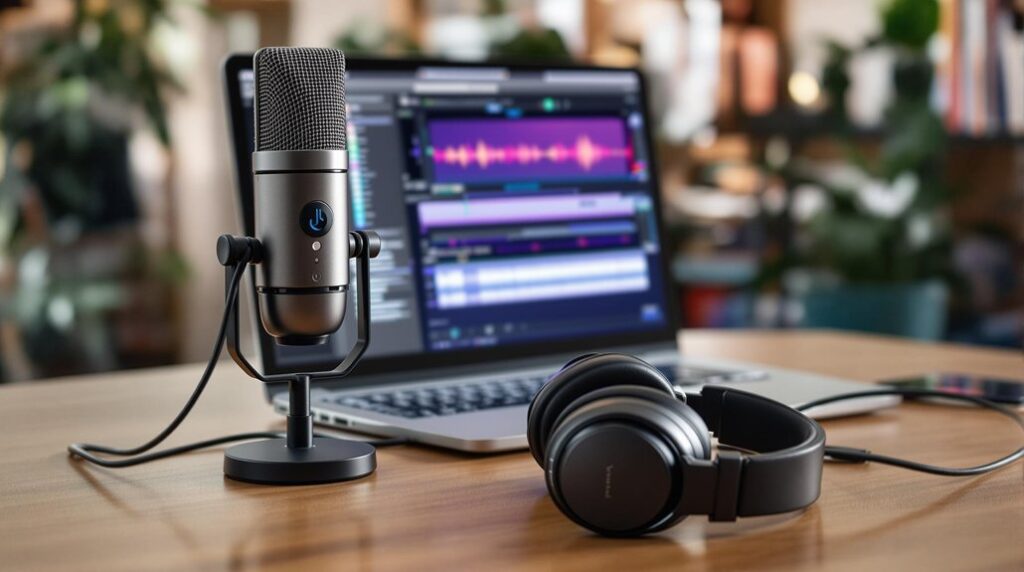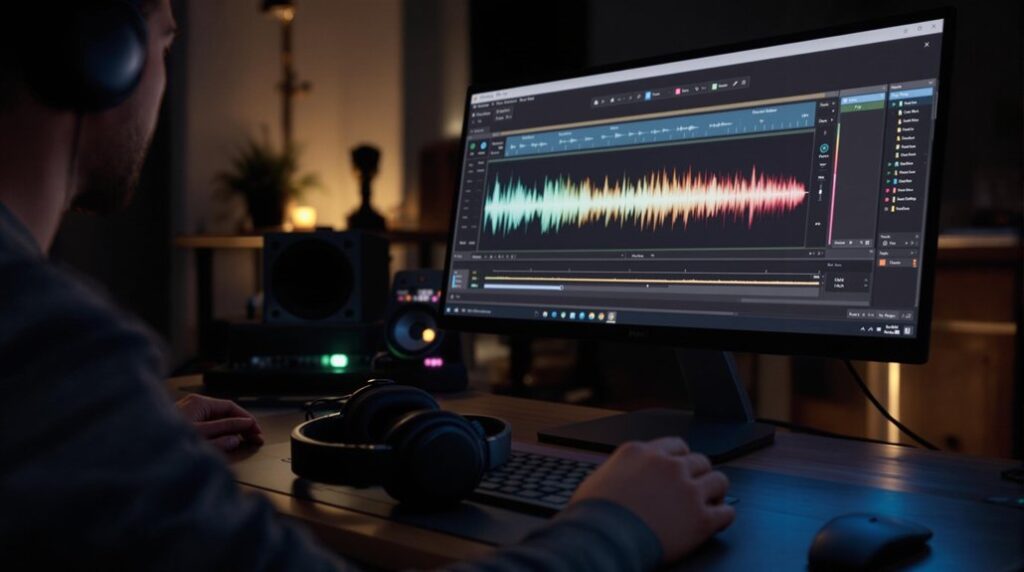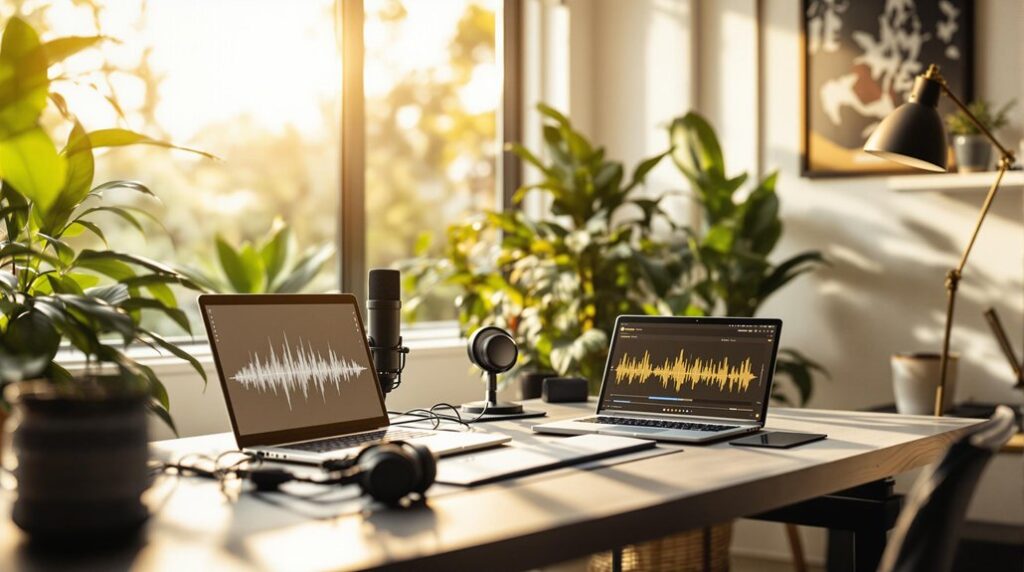To change the sample rate in Audacity, start by installing the software and loading your audio files. Check the project sample rate displayed in the lower left corner; it usually defaults to 44,100 Hz. If you need to change it, select a new rate from the Project Rate menu or use the “Resample” option in the Tracks menu. Adjust the bit depth to 16-bit for compatibility. Finally, save your export settings and verify the output properties to confirm everything matches your desired sample rate. These steps will help you optimize your audio project for the best quality and performance.
Key Takeaways
- Open your project in Audacity and check the current sample rate displayed in the lower left corner.
- To change the sample rate, select the desired rate from the Project Rate dropdown menu.
- If needed, use the “Resample” option in the Tracks menu to input a specific sample rate.
- Ensure the project sample rate matches the desired output rate before exporting the audio.
- Export the audio by selecting “WAV (Microsoft) signed 16-bit PCM” for best compatibility.
Install Audacity
To get started with Audacity, you’ll first need to install the software. Download version 2.1.1, which requires administrative privileges for the installer, or opt for the portable version for easier setup without installation hassles.
Once installed, launch Audacity and navigate to Preferences to change the default quality settings. It’s essential to set the Default Sample Rate to 11025 Hz and the Sample Format to 16-bit for ideal audio quality.
Remember, you’ll be saving your final audio files in .wav format since exporting to .mp3 necessitates the LAME plugin.
Familiarize yourself with the audio content by playing the track briefly, ensuring it’s loaded correctly before diving into your editing tasks.
Load Audio Files
Loading audio files into Audacity is straightforward.
Begin by directing yourself to the File menu and selecting “Open” to browse your computer for the desired audio files. Audacity supports various formats, including WAV, MP3, and AIFF, giving you the flexibility to load audio files that suit your project.
It’s advisable to check the option “Make a copy of the files before editing” to safeguard your originals. Once loaded, the audio files will appear in the main window, allowing you to play them back and assess their audio quality.
To guarantee peak editing and playback compatibility, make sure that the sample rate of each file aligns with your project’s sample rate.
Check Project Sample Rate
After you’ve successfully loaded your audio files, it’s important to check the project sample rate in Audacity. You can find the sample rate displayed in the lower left corner of the interface. The default project sample rate is typically 44,100 Hz, which is standard for CD-quality audio. Often, this rate aligns with the first audio file’s sample rate when imported. Verifying the sample rate before making edits is essential for ensuring compatibility and maintaining audio quality. If you notice discrepancies, adjustments can be made through the Audio Settings menu. Additionally, using EQ settings can help optimize sound quality based on the chosen sample rate.
| Sample Rate (Hz) | Description | Standard Use |
|---|---|---|
| 44,100 | CD Quality | Music Production |
| 48,000 | Video Production | Film and TV |
| 96,000 | High-Resolution Audio | Professional Mixing |
| 192,000 | Ultra High-Resolution | Archiving |
| 32,000 | Low Quality | Voice Recordings |
Change Sample Rate
To change the sample rate in Audacity, access the sample rate menu from the “Tracks” menu and select “Resample” or adjust the project sample rate from the drop-down next to the project name.
After resampling, make certain to export your audio file at the correct sample rate to guarantee quality and compatibility.
Always check that the project rate in the lower-left corner matches your desired output rate before saving.
Accessing Sample Rate Menu
When you need to change the sample rate in Audacity, the first step is to locate the Project Rate in the lower-left corner of the interface, which indicates your project’s current sample rate.
To access the sample rate menu, follow these steps:
- Click the drop-down menu next to the Project Rate to choose a new sample rate, like 44,100 Hz for CD-quality audio.
- Alternatively, go to the Tracks menu and select “Resample.”
- Enter your desired sample rate for the selected audio track.
- After making changes, verify the new sample rate is compatible with your intended output or device.
Resampling Audio Files
Resampling audio files in Audacity allows you to efficiently change the sample rate of your tracks without losing quality.
To begin, navigate to the “Tracks” menu and select the “Resample” option. Here, you can choose your desired sample rate, such as 44,100 Hz.
Before you proceed, verify the project sample rate displayed in the lower-left corner matches this new rate. You can adjust the overall sample rate for your project by modifying the “Project Rate” setting found in the Audio Settings menu.
For batch processing, simply add multiple audio files and use the “Export Audio” feature to apply a consistent sample rate across all files, confirming compatibility with your playback devices.
Exporting Changes Properly
Before you export your audio file with the desired sample rate in Audacity, it’s essential to verify that your project settings align with your export intentions.
Follow these steps to guarantee a smooth export:
- Check the Project Rate in the lower-left corner; adjust to 44,100 Hz if necessary.
- Go to the File menu and select “Export.”
- Set “Save as type” to WAV (Microsoft) signed 16-bit PCM for compatibility.
- In the export dialog, confirm the “Sample Rate” is set to 44,100 Hz to maintain audio quality.
After selecting the desired file name and location, click “Save” and finalize any additional settings.
This process verifies your audio retains its intended quality while exporting.
Adjust Bit Depth
Adjusting the bit depth in Audacity is vital for achieving the desired audio quality in your projects. To change the bit depth, navigate to the “Edit” menu, select “Preferences,” and then choose the “Quality” tab to set the Default Sample Format.
Audacity typically offers 16-bit, 24-bit, and 32-bit options, with 16-bit being standard for CD-quality audio. Keep in mind that altering the bit depth impacts the dynamic range; 24-bit provides higher fidelity and more headroom for professional recordings. Additionally, maintaining proper gain staging is crucial for enhancing the impact and professionalism of your final track.
It’s important to make these adjustments before exporting your final audio file to guarantee compatibility with your intended playback system. Remember, reducing the bit depth results in a loss of audio quality, so consider the final use before making changes.
Save Export Settings
When you’re ready to save your audio project in Audacity, it’s crucial to configure the export settings correctly. Follow these steps to guarantee your file is saved properly:
- Navigate to the File menu and select Export to access the file-saving settings.
- Set the Save as type to WAV (Microsoft) signed 16-bit PCM for best compatibility with standard audio formats.
- Name your exported file concisely, ideally keeping it under 10 characters for easy recall.
- Choose the desired location on your computer for easy access later.
Before finalizing the export, double-check all settings, including sample rate and file format, to confirm they align with your project requirements.
This attention to detail guarantees a smooth saving process.
Verify Final Output
To guarantee your final output meets your expectations, start by verifying the sample rate in Audacity. Check the Project Rate in the lower-left corner; it should match your desired output, like 44,100 Hz.
After resampling, play back the audio to confirm the pitch and playback speed are consistent with the original recording. When you’re ready to export, verify that the sample rate option in the export dialog reflects your intended settings to maintain audio quality.
Utilize the “Tracks” menu to review each track’s properties, confirming the sample rate aligns with the project settings. Finally, double-check the exported file using a media player that displays audio properties to validate the sample rate is as expected. Additionally, ensuring you use high-quality, lossless file formats for export will further preserve your audio’s integrity.
Frequently Asked Questions
How to Adjust Sample Rate in Audacity?
To adjust the sample rate in Audacity, you’ll access the editing tools, check the sample rate in the lower-left corner, and select your desired rate to enhance audio quality before exporting your project.
How to Change Audio Sample Rate?
To change the audio sample rate, adjust your recording settings in the software. Higher sample rates improve audio quality, so confirm compatibility with your project settings and export options for peak results.
How to Speed up Samples in Audacity?
To speed up samples in Audacity, select your track, go to “Effect,” and choose “Change Tempo.” Adjust the percentage for audio editing. Remember, after speeding samples, export at your desired sample rate for compatibility.
How Do I Change Sample Rate From 48 to 44.1 in Pro Tools?
To change the sample rate from 48 kHz to 44.1 kHz in Pro Tools, adjust the settings in the Session Setup dialog. Make certain you perform sample rate conversion for effective audio project management. Save your session afterward.
Conclusion
In just seven easy steps, you can effectively change the sample rate in Audacity to suit your audio needs. By installing the software, loading your files, and adjusting the project sample rate and bit depth, you guarantee ideal sound quality. Don’t forget to save your export settings for future use. Finally, always verify your final output to confirm that the changes meet your expectations. With these steps, you’ll have complete control over your audio projects.




